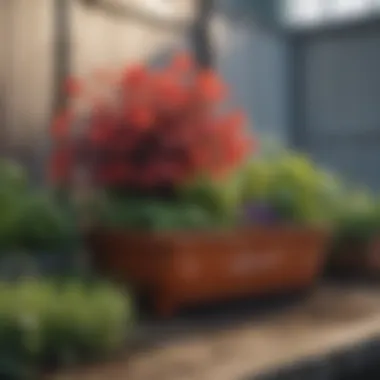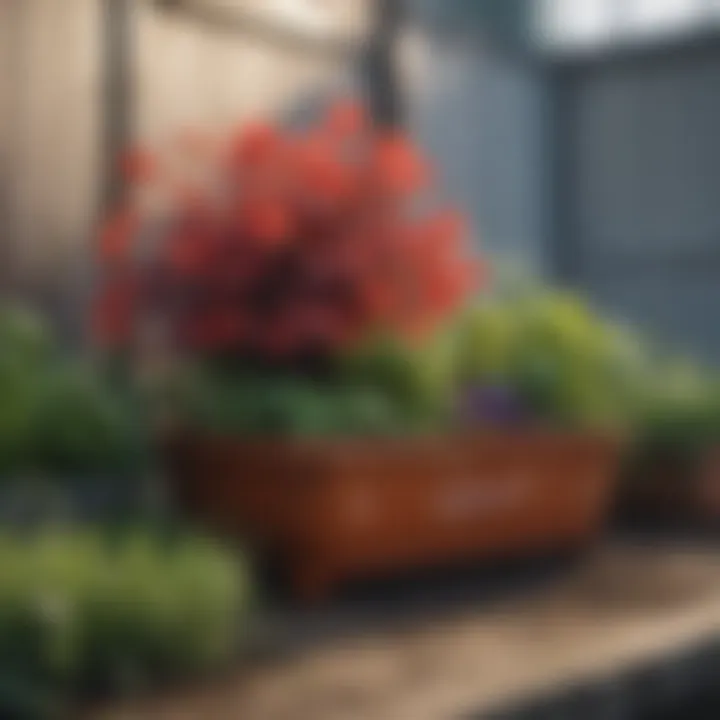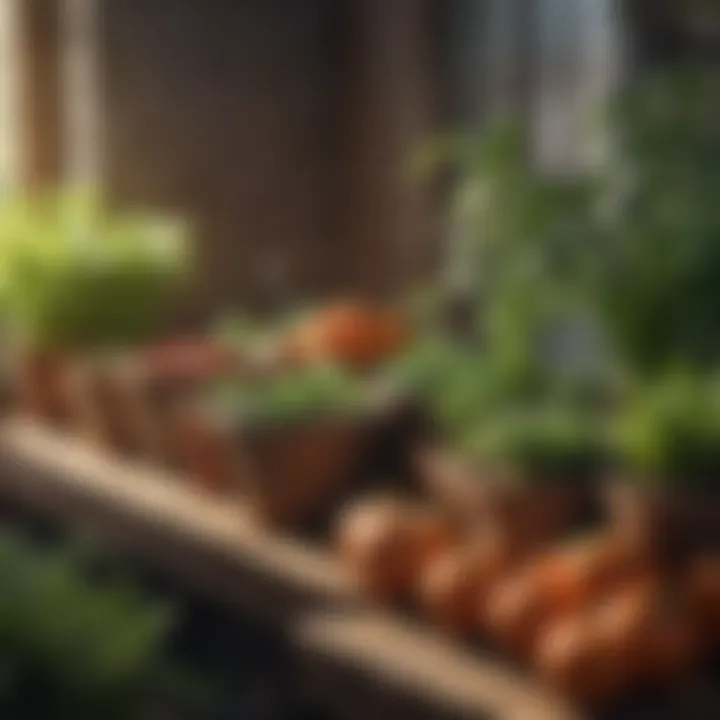Top Vegetables to Grow Successfully in Small Pots


Intro
Urban living often comes with challenges, especially when it comes to cultivating fresh produce. Limited space is a common issue for many city dwellers. However, small pots offer an ingenious solution. Growing vegetables in containers can be both practical and rewarding. Not only does it allow for gardening in confined areas, but it also promotes sustainability by reducing the carbon footprint involved in transporting food.
This article will explore vegetables that thrive in small pots, essential growing conditions, pot selection, soil mixture, and maintenance practices to ensure a bountiful yield. You will understand how to maximize your gardening potential, even in the smallest of spaces.
Benefits of Container Gardening
Growing vegetables in small pots provides numerous benefits. These include:
- Space Efficiency: Small pots can fit almost anywhere, whether on a balcony, patio, or even indoors.
- Accessibility: Gardening in pots makes it easier to tend to your plants, reducing the need to bend down or navigate uneven ground.
- Controlled Environment: Container gardening allows you to have more control over soil quality and moisture levels, which can lead to healthier plants.
- Aesthetic Appeal: Carefully arranged pots can add beauty to any space.
"Container gardening can transform even the smallest areas into productive green spaces."
Selecting the Right Vegetables
Not all vegetables are suited for container gardening. Here are some ideal options:
- Lettuce: Fast-growing and can thrive in shallow containers.
- Radishes: Requires minimal space and quick to harvest.
- Herbs: Such as basil, cilantro, and parsley; they do well in small pots and are useful in the kitchen.
- Cherry Tomatoes: Compact varieties can thrive in pots and produce abundant fruit.
When choosing vegetables, consider your own culinary preferences and the amount of sunlight available in your gardening space.
Conditions for Optimal Growth
For plants to flourish in small pots, certain conditions must be met:
- Sunlight: Most vegetables need at least six hours of direct sunlight daily. Assess your space to determine if it can provide this requirement.
- Watering: Plants in pots can dry out faster than those in the ground. Regularly check for moisture and water as needed.
- Fertilization: Use a balanced fertilizer to nourish the plants, usually every four to six weeks during the growing season.
End
Container gardening offers urban residents an opportunity to cultivate their own food, no matter the size of their living space. By selecting appropriate vegetables and ensuring ideal growing conditions, it is possible to enjoy a fruitful harvest all while embracing a sustainable lifestyle. You will find that growing food in small pots not only provides fresh produce but also serves as a rewarding hobby.
Foreword to Container Gardening
Container gardening is a concept that has gained momentum in recent years, especially as urban living spaces become more confined. The practice allows individuals to grow a variety of plants, particularly vegetables, in limited spaces. This method is especially appealing for those who may not have traditional gardens but still desire fresh produce.
One notable advantage of growing vegetables in small pots is the control it offers over soil quality and water drainage. Various types of containers can be used, including plastic, terracotta, and fabric. Each type has its benefits and can influence plant growth.
Moreover, container gardening encourages sustainable practices. It is often more manageable, allowing for more organic gardening practices. The convenience of having plants in small pots means they can easily be moved to optimize sunlight exposure or to protect them from adverse weather conditions.
In this guide, we will explore the specific vegetables suitable for container gardening and how each contributes to a productive home garden. Additionally, we’ll examine the necessary conditions for optimal growth, pot selection, soil composition, and maintenance. The goal is to provide insights and practical advice for those looking to cultivate their own vegetables in small pots, paving the way for a rewarding gardening experience.
Defining Container Gardening
Container gardening involves planting in pots and other types of containers rather than in the ground. This technique is not limited to vegetables; it can include flowers, herbs, and various types of ornamental plants. However, the focus here is on vegetables that thrive in smaller environments. Each container can vary in size, shape, and material, allowing for a versatile gardening approach.
The beauty of container gardening lies in its flexibility. It enables individuals to grow plants on balconies, patios, or even indoors. For many, it represents an accessible way to engage with nature and cultivate hobbies, enhancing indoor air quality and providing a sense of achievement.
The Appeal of Growing Vegetables in Small Pots
There are numerous reasons for the appeal of growing vegetables in small pots. First, this method is ideal for urban dwellers or anyone with limited access to traditional garden space. Small pots can easily be set up on a balcony or windowsill, making them accessible to a broader audience.
Another compelling reason is the flexibility in design. Gardening in small pots allows for a creative arrangement of plants. It’s common for individuals to mix various plant types within a single pot, promoting companion planting. This can enhance growth and even flavor, leading to a more enriching gardening experience.
Furthermore, cultivating vegetables in pots can lead to quicker harvests. Many varieties are suited to smaller spaces and can often be grown in shorter cycles. For those with time constraints, this is an essential consideration.
Container gardening is not merely a trend; it is a sustainable solution for modern living. It embodies an efficient use of available space while promoting self-sufficiency through home-grown produce.
In summary, container gardening offers a practical and fulfilling way to engage with horticulture in modern-day settings. As we delve deeper into the types of vegetables suitable for small pots, we will uncover more insights about this rewarding gardening method.
Selecting the Right Vegetables
Choosing the correct vegetables is crucial for success in small pot gardening. Understanding which types of vegetables can thrive in limited space will not only enhance your gardening experience but will also ensure a productive yield. Different vegetables have distinct growth habits and environmental needs. Thus, careful selection is essential to maximize the efficiency of your gardening efforts.
The right choice can lead to higher yields, better flavor, and overall satisfaction with your gardening projects. In this section, we will explore some specific categories of vegetables suitable for small pots, as well as key factors that should guide your decision-making process.
Best Vegetables for Small Pots


Leafy Greens
Leafy greens are an ideal choice for container gardening. They are known for their relatively short growth cycles and compatibility with smaller growing spaces. Varieties such as spinach, lettuce, and kale can be cultivated in shallow pots, making them perfect for urban gardeners. The quick harvest period allows for multiple planting cycles throughout the year, maximizing production.
One key characteristic of leafy greens is their ability to grow well in partial shade, which offers flexibility in where pots can be placed. However, crowded conditions can lead to smaller leaves. Regular harvesting encourages new growth, adding to a steady supply of fresh produce.
Herbs
Herbs rank among the most popular and beneficial options for small pot cultivation. They require less space and can often thrive in smaller containers. Basil, parsley, and cilantro are excellent choices that complement various dishes. Growing herbs offers both culinary and aesthetic benefits, as they can also add aromatic qualities to outdoor spaces.
A unique feature of herbs is their ability to grow indoors or outdoors, which provides gardeners with versatility. Consider that some herbs prefer well-drained soil to sprawling roots, making proper pot selection of utmost importance.
Root Vegetables
Root vegetables, like radishes and carrots, can be surprisingly effective in small pots if conditions allow. They require deeper soil than many surfaces greens. This need must be accounted for when selecting pots. Additionally, root vegetables offer a rewarding experience; watching them grow underground can be quite fulfilling.
The main advantage of growing root vegetables is their ability to provide substantial harvests from limited space. However, they can be sensitive to overcrowding in pots, which may stunt their growth and lead to smaller yields.
Compact Varieties of Common Vegetables
Compact varieties of commonly known vegetables such as tomatoes, peppers, and cucumbers have been developed specifically for small spaces. These varieties allow urban gardeners to enjoy classic vegetables without needing considerable gardening areas. They maintain a smaller size, more suitable for pots compared to their full-sized counterparts.
A key benefit of growing these compact varieties is their fruit production, which can be quite high despite the limited space. However, they often require more sunlight; thus, the positioning of pots is crucial for successful yield throughout the season.
Factors to Consider When Choosing Vegetables
Growth Height
The growth height of the vegetable is paramount when choosing for small pots. Tall varieties may not fit well or may overshadow smaller plants. Generally, it is wise to prioritize choices that remain compact. This consideration helps ensure that light and nutrients are accessible to all plants in your container garden.
A significant feature regarding height is limiting overshadowing for smaller plants, which can restrict their growth. Therefore, mixing taller plants with shorter options could be beneficial as long as their needs are balanced.
Root Depth Requirement
Depth of roots is another crucial consideration. Some vegetables require more soil depth than others and may need larger pots. Understanding the root depth requirement of each plant ensures you choose pots that can accommodate proper growth.
If root space is inadequate, it may lead to stunted growth, limited nutrient absorption, and an overall unsuccessful harvest.
Growth Cycle Duration
The duration of the growth cycle can significantly affect your gardening experience. Plants with shorter cycles allow for quicker turnovers. This means you can harvest and replant more frequently. On the contrary, longer growth cycle plants may require more attention and patience.
Short-cycle vegetables can be a practical choice in urban gardening, providing a consistent fresh supply. However, longer-cycle vegetables can offer richer flavors or larger yields, adding variety to your gardening attempts.
Selecting the right vegetables is a critical step that can influence the success of your container gardening efforts.
Pot Selection and Preparation
Choosing the right pot is essential when it comes to container gardening. The selection of pots affects not only the look of the garden but also the growth and health of the vegetables. Proper pot selection ensures that plants have enough space for roots to develop, enables adequate drainage, and supports the overall growth environment. Understanding the different types of pots available can lead to better cultivation practices and higher yields.
Types of Pots Suitable for Vegetables
Plastic Pots
Plastic pots are commonly used in container gardening due to their lightweight nature. Their affordability makes them a popular choice. They come in various sizes, allowing flexibility in the number of plants you can grow. A significant advantage of plastic pots is their ability to retain moisture better than other materials. This is beneficial during hot weather when plants require consistent hydration. However, their lightweight nature might cause them to tip over in strong winds, and they do not provide the same aesthetic appeal as other materials.
Terracotta Pots
Terracotta pots are made from clay and provide excellent airflow to the plant roots. This characteristic allows for a balance between moisture retention and drainage, which is vital for vegetable growth. These pots have a rustic look, appealing to gardeners who value aesthetics alongside functionality. However, terracotta can absorb moisture, which means they may require more frequent watering. Moreover, they can be heavier, which may not be ideal for some urban environments where moving them can be cumbersome.
Fabric Pots
Fabric pots, also known as grow bags, are increasingly popular for container gardening. They allow excellent aeration to the roots, promoting healthier plant growth. The key characteristic of fabric pots is their flexibility; they can be made in various sizes and easily stored when not in use. They are also lightweight and encourage air pruning of roots, which can enhance the overall development of plants. However, they tend to dry out faster than other pots, necessitating more frequent watering.
Soil Composition for Optimal Growth
The soil used in pots plays a crucial role in the success of growing vegetables. Understanding the difference between potting mix and garden soil can greatly influence plant health.
Potting Mix vs. Garden Soil


Potting mix is specially formulated for container plants and typically contains components like peat moss, coconut coir, and perlite. This combination provides better drainage and aeration, two factors essential for healthy root development. In contrast, garden soil is denser and may not drain adequately in pots, leading to potential root rot. Therefore, using potting mix can be a more beneficial choice for growing vegetables in small pots.
Soil Drainage Requirements
Proper drainage is vital for container gardening. Soil should allow excess moisture to escape while still retaining enough to nourish the plant. Good drainage helps prevent common issues like root rot and fungal diseases. A pot with drainage holes is essential. Even with the right soil, if the pot does not allow water to exit, plants can struggle to thrive.
Organic Amendments
Incorporating organic amendments into potting soil can significantly boost plant health. Options like compost, worm castings, or fish emulsion provide essential nutrients. These amendments improve soil structure and fertility, leading to more vigorous vegetable growth. They can also enhance the microbial life in the soil, contributing to a balanced ecosystem that benefits plants. However, it is important to not overdo it, as excessive organic material can lead to nutrient burn.
Creating the Ideal Growing Conditions
Creating the right growing conditions is crucila for the successful cultivation of vegetables in small pots. Factors such as light, water, and overall environment can significantly influence plant health and productivity. When growing vegetables in limited spaces, understanding these elements helps to maximize yield and ensures that your efforts are rewarded with bountiful harvests.
Light Requirements for Container Vegetables
Full Sun vs. Partial Shade
Lighting plays a significant role in the growth of container vegetables. Full sun typically means receiving at least six to eight hours of direct sunlight daily. This is typically a beneficial choice, especially for vegetables like tomatoes and peppers that thrive on abundance of light. On the other hand, partial shade provides some relief from intense sunlight, allowing for a balance of light and protection. Greens like lettuce and spinach often yield better in partial shade, which can prevent them from bolting too quickly in hot weather.
A key characteristic of full sun is its ability to promote faster growth and healthier plants, often resulting in more robust flavors. However, it can also lead to issues such as wilting during extreme heat. Partial shade may slow growth but can produce sweeter, more tender leaves in some vegetables. Understanding the light needs specific to your vegetable choices can greatly affect your garden's outcome.
Positioning Pots for Optimal Light Exposure
Positioning pots strategically is essential to ensuring that your vegetables receive adequate light. Containers can be placed on balconies, patios, or even window sills, but alignment with sunlight patterns is critical. South or west-facing locations often capture the most sun, making them ideal spots for growing sun-loving plants.
A key advantage of proper positioning is that it increases the efficiency of your space, maximizing sunlight intake and minimizing shading from other structures or plants. Unique features such as rotating pots to track the sun can also improve light exposure, compensating for limited direct light periods during the day. Be aware that while positioning enhances growth potential, it also requires regular attention to seasonal changes in sun direction.
Watering Techniques and Frequency
Signs of Overwatering and Underwatering
Water management is crucial for container-grown vegetables. Identifying signs of overwatering includes yellowing leaves, soggy soil, and stunted growth. Conversely, underwatering often manifests as wilting leaves, dry soil, and a general lethargy in plant vigor. Recognizing these signs is a fundamental attribute for any successful container gardener. Adequate water levels support root establishment and overall growth conditions.
The distinctive challenge is finding the balance; too much water can drown roots, while insufficient moisture can lead to dehydration and stress. Monitoring your plants’ reactions to watering can help in developing an effective schedule tailored to each specific vegetable type.
Best Practices for Watering Small Pots
Best practices include assessing moisture levels before watering. A typical recommendation is to stick your finger into the soil about an inch deep. If it feels dry, it's time to water. Another crucial practice is watering evenly, ensuring moisture reaches all aspects of the root zone. Consider using self-watering pots if finding time to check on plants is difficult.
Using these methods helps to maintain consistent moisture levels, preventing stress on the plants and ultimately leading to better yields. It is advantageous when establishing consistent schedules that coincide with both growth stages of the vegetables and seasonal climate variations, leading to healthier plants.
"The success of container gardening heavily relies on diligent observation and adjustment of one's practices based on plant responses."
By fostering the right growing conditions through light and watering practices, you can significantly increase the success rate of your small pot vegetable garden.
Maintenance and Care for Container Vegetables
The process of growing vegetables in small pots demands regular upkeep. This maintenance is vital to ensure successful harvests and sustained plant health. Container vegetables, due to their restricted soil volume, require more attention than those grown directly in the ground. By focusing on proper care practices, gardeners can enhance yields and ensure robust growth. Understanding the nuances of maintenance makes a significant difference in the gardening experience and ultimately affects the quality of produce.
Fertilization Practices
Types of Fertilizers
Fertilizers play a crucial role in the health of container vegetables. They provide essential nutrients needed for growth, including nitrogen, phosphorus, and potassium. There are primarily two categories of fertilizers: synthetic and organic. Synthetic fertilizers are chemical-based and are known for their quick release of nutrients. They can provide a rapid boost to plants but may lead to nutrient burn if not applied correctly. Organic fertilizers, such as compost or well-rotted manure, release nutrients slowly. This gradual process is beneficial, as it reduces the risk of over-fertilization. The unique feature of organic options is their ability to improve soil structure and promote beneficial microbial activity.
Application Frequency and Method
Proper application frequency and method of fertilization ensure that plants receive nutrients at the right time. Generally, container vegetables benefit from fertilization every four to six weeks during the growing season. Liquid fertilizers can be diluted in water and applied during regular watering. This method allows for a steady intake of nutrients. Solid fertilizers may require mixing into the soil or top-dressing, which might be less effective for immediate nutrient uptake. Notably, adjusting the frequency based on vegetable type and growth stage can maximize the potential benefits. While over-fertilizing may cause rapid growth, it could also lead to weaker plants that struggle under their own weight.
Pest and Disease Management
Common Pests Affecting Container Vegetables
Pest management is another critical factor in maintaining healthy container gardens. Common pests like aphids, spider mites, and whiteflies can pose significant threats to vegetable plants. Understanding these pests helps in recognizing early signs of infestations. For example, aphids may cluster on new growth, while spider mites produce webbing on leaves. The characteristics of these pests make them easy targets for control methods. Regular monitoring and prompt action can prevent severe damage. Distinguishing between beneficial insects and pests also assists in fostering a healthy garden ecosystem.
Organic Pest Control Methods
Organic pest control methods offer safer alternatives to chemical pesticides. Techniques such as introducing beneficial insects, like ladybugs or lacewings, can effectively suppress pest populations. Other methods include using neem oil, insecticidal soaps, or even homemade sprays with garlic or pepper. These methods minimize harm to beneficial organisms in the garden and reduce chemical residues on produce. The unique feature of organic pest control is its sustainability, as it promotes long-term health for the garden environment. While they may require more effort and time, these methods are less harmful and support a more holistic approach to gardening.


In summary, effective maintenance and care practices are fundamental to achieving success in container gardening. By focusing on fertilization and pest control methods, gardeners can significantly enhance the quality and quantity of their harvests.
Maximizing Yield from Small Pots
Maximizing yield from small pots is essential for any container gardener looking to make the most of limited space. Growing vegetables in confined areas presents unique challenges, but with the right strategies, one can achieve impressive results. The practice of maximizing yield not only enhances productivity but also contributes to sustainable gardening practices. By utilizing companion planting and succession planting techniques, gardeners can effectively boost the overall output of their small vegetable gardens.
Companion Planting Strategies
Companion planting is the art of growing different types of plants close together for mutual benefit. Certain plant combinations can enhance growth, deter pests, and improve overall health. For instance, planting basil alongside tomatoes can improve the tomato's taste while repelling some common pests.
Benefits of Companion Planting:
- Pest Control: Specific plants can ward off insects that are harmful to others.
- Nutrient Enhancement: Some plants, like legumes, fix nitrogen in the soil, benefiting neighboring plants.
- Space Optimization: Taller plants can offer shade to shorter ones, making efficient use of vertical space.
When planning companion gardens in pots, consider the following combinations for small spaces:
- Lettuce and Radishes: They share nutrients and have different root depth requirements.
- Carrots and Onions: Onions repel carrot flies, making this combination enjoyable for both crops.
- Chili Peppers and Spinach: Peppers benefit from spinach's low growth habit.
Succession Planting Techniques
Succession planting involves staggering the planting of crops to ensure a continuous harvest throughout the growing season. This technique is particularly effective in small pots as it allows gardeners to maximize the use of available space over time.
Key Aspects of Succession Planting:
- Timing: Different vegetables have varied growing times. By knowing these, gardeners can plant new crops just as old ones are harvested.
- Diversity: Growing a mix of fast and slow-growing plants can ensure that at any time, there is something maturing.
- Seasonality: Adjust planting times based on the seasons to benefit from cool-season and warm-season crops.
For example, after harvesting lettuce, one can immediately replant with radishes, taking advantage of the same pot. Additionally, crops like zucchini can be planted after earlier root crops have been pulled out.
"Maximizing yield from small pots is not just a matter of quantity; it’s about creating a fruitful relationship between plants to ensure that every inch of soil is used wisely."
By carefully planning plant combinations and timing, any gardener with limited space can enjoy a productive and diverse vegetable garden.
Harvesting and Enjoying Your Produce
Harvesting and enjoying your own vegetables is a rewarding aspect of container gardening. Cultivating plants in small pots allows individuals to experience the satisfaction of producing food even in limited spaces, such as balconies or small yards. This section explains the significance of timing and techniques in harvesting and how to store and utilize the produce effectively. Understanding these elements ensures that one not only enjoys fresh vegetables but also maximizes their efforts.
Timing for Harvesting Different Vegetables
Timing is crucial when it comes to harvesting vegetables. Picking them at the right moment influences taste, texture, and nutritional value. Each type of vegetable has its unique growth cycle and signals that indicate when it is ready for harvest.
For instance, leafy greens like spinach and lettuce are best harvested when the leaves are young and tender. Waiting too long can result in bitterness. In contrast, root vegetables such as radishes and carrots should be harvested when they reach the desired size, usually indicated by the top peeking above the soil line.
Key points to consider include:
- Visual Cues: Look for color and size changes in the vegetables.
- Days to Maturity: Each plant has a specific number of days from planting to harvest. Keep track of this to estimate when your vegetables will be ready.
- Taste Testing: For some vegetables, such as beans, a taste test can also help determine the perfect harvest time.
"Harvesting vegetables at peak ripeness ensures the best flavor and texture."
Storage and Usage of Homegrown Vegetables
Storing homegrown vegetables properly extends their freshness and usability. Each type of vegetable has particular storage needs.
- Leafy Greens: Store in perforated plastic bags in the refrigerator to maintain moisture while allowing for airflow.
- Root Vegetables: Keep them in a cool, dark place, such as a basement or cellar. This prevents sprouting and keeps them firm.
- Fruits and Peppers: These can usually be stored at room temperature for a few days but should be moved to the refrigerator for longer storage.
Using homegrown vegetables is a great way to enhance meals. Fresh ingredients bring flavors to life and promote healthy eating. Consider incorporating these vegetables into your meals:
- Salads featuring leafy greens and herbs
- Stir-fries with mixed vegetables
- Roasted root vegetables as side dishes
The End
Growing vegetables in small pots offers numerous advantages that resonate well with today’s urban lifestyle. Container gardening is a practical solution for individuals with limited space. It not only allows for the cultivation of fresh produce but also encourages sustainable living practices. Small pots eliminate the need for large gardens, enabling anyone from apartment dwellers to busy professionals to engage with gardening.
Reflecting on the Benefits of Container Gardening
Container gardening provides flexibility in plant placement. This means that vegetables can be grown on balconies, rooftops, or even window sills. The ability to control soil quality is another significant benefit. Since containers are portable, one can easily adjust their location to ensure optimal sunlight, which is crucial for vegetable growth. Moreover, smaller areas make it easier to monitor for pests and diseases, allowing for quicker interventions.
One of the main appeals to this gardening style is the faster accessibility to fresh vegetables. Growing leafy greens, herbs, and other quick-yield vegetables can create a direct connection to one’s food source. Tools and supplies can also be minimal, making it ideal for those just starting with gardening. The cultivation of vegetables in a confined area often leads to greater satisfaction and a sense of accomplishment.
Future Perspectives on Urban Gardening
As urban areas continue to expand, the demand for sustainable food sources increases. More people are recognizing the importance of growing their own ingredients, fostering a deeper appreciation for food. The rise of precision agriculture and hydroponics means that even those with minimal outdoor space can experiment with sophisticated growing methods.
Moreover, community gardens and urban co-ops are gaining traction. These initiatives not only provide space for growing but also encourage a communal spirit. Connecting with neighbors through shared gardening experiences strengthens social bonds that are often lost in city living. The trends indicate a shift toward greener cities where vegetation and urban life coexist harmoniously. As more individuals invest in container gardening, the collective knowledge and resources will only enhance the outcomes, paving the way for more sustainable living practices.
Embracing container gardening today shapes the future of urban agriculture, fostering community, sustainability, and robust urban ecosystems.







